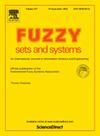Representations of the fuzzy implications satisfying the law of left or right contraposition
IF 2.7
1区 数学
Q2 COMPUTER SCIENCE, THEORY & METHODS
引用次数: 0
Abstract
In this paper, we focus on exploring three types of representations of the fuzzy implications on the real unit interval that satisfy the law of left or right contraposition. This study involves the use of continuous or non-continuous fuzzy negations on the real unit interval. Under the assumption that a continuous fuzzy negation is given, we respectively exploit -implications, -implications and -implications to represent the fuzzy implications satisfying the law of left or right contraposition. In particular, we investigate the conditions under which a given fuzzy implication is an -implication, and discuss the relationships among certain types of fuzzy implications (including -implications, -implications and -implications) that are related to the law of left or right contraposition. Assuming the presence of a non-continuous fuzzy negation, we proceed to utilize -implications, -implications or -implications to represent the fuzzy implications that satisfy the law of left or right contraposition. Notably, by exploiting the law of left contraposition together with appropriate conditions, we characterize -implications associated with a non-continuous fuzzy negation.
满足左或右对位律的模糊含义的表示
本文主要研究满足左或右对位律的实单位区间模糊蕴涵的三种表示形式。本研究涉及在实单位区间上使用连续或非连续模糊否定。在给定连续模糊否定的假设下,我们分别利用(H,N)-蕴涵、(C,N)-蕴涵和(D,N)-蕴涵来表示满足左右对位律的模糊蕴涵。特别地,我们研究了给定的模糊蕴涵是(H,N)-蕴涵的条件,并讨论了与左或右对位律有关的某些类型的模糊蕴涵(包括(H,N)-蕴涵、(C,N)-蕴涵和(D,N)-蕴涵)之间的关系。假设存在不连续模糊否定,我们继续利用(H,N)-蕴涵、(C,N)-蕴涵或(D,N)-蕴涵来表示满足左右对位律的模糊蕴涵。值得注意的是,通过利用左对位律以及适当的条件,我们表征了与非连续模糊否定相关的(S,N)-含义。
本文章由计算机程序翻译,如有差异,请以英文原文为准。
求助全文
约1分钟内获得全文
求助全文
来源期刊

Fuzzy Sets and Systems
数学-计算机:理论方法
CiteScore
6.50
自引率
17.90%
发文量
321
审稿时长
6.1 months
期刊介绍:
Since its launching in 1978, the journal Fuzzy Sets and Systems has been devoted to the international advancement of the theory and application of fuzzy sets and systems. The theory of fuzzy sets now encompasses a well organized corpus of basic notions including (and not restricted to) aggregation operations, a generalized theory of relations, specific measures of information content, a calculus of fuzzy numbers. Fuzzy sets are also the cornerstone of a non-additive uncertainty theory, namely possibility theory, and of a versatile tool for both linguistic and numerical modeling: fuzzy rule-based systems. Numerous works now combine fuzzy concepts with other scientific disciplines as well as modern technologies.
In mathematics fuzzy sets have triggered new research topics in connection with category theory, topology, algebra, analysis. Fuzzy sets are also part of a recent trend in the study of generalized measures and integrals, and are combined with statistical methods. Furthermore, fuzzy sets have strong logical underpinnings in the tradition of many-valued logics.
 求助内容:
求助内容: 应助结果提醒方式:
应助结果提醒方式:


